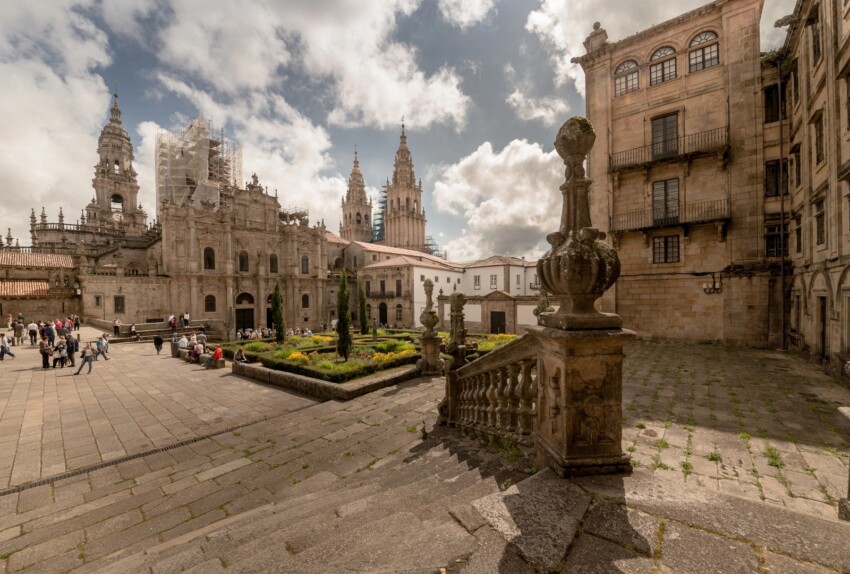

Located at the north-western tip of Spain, Santiago de Compostela, capital of the Galicia region, is the emblem of the journey: the iconic end of the world’s most famous walking route, it is a city with a charm that is too often underestimated.
The arrival in Santiago is for those who arrive here on foot the greatest emotion, but take the time to get to know in depth this city about which, apart from the route to which it gives its name, very little is generally known.
Don’t expect the stereotypical image of caliente Spain with year-round sunshine: the landscapes of Galicia are more reminiscent of northern countries like Ireland or England than the sunny regions of southern Spain. Galicians are somewhat atypical Spaniards for the image many have of Spain, generally more reserved but very friendly, with their own language, strong traditions handed down over the centuries and a very rich gastronomic tradition.
Forget also the common stereotype that sees Santiago de Compostela as a sacred and morose city: while it is undeniable that the city is pervaded by a powerful aura of sacredness, it is also true that today the capital of Galicia is fun, cheerful and jovial, thanks also to its lively university.
The centre of Santiago de Compostela, full of historic palaces and elegant stone and granite squares, is beautiful to walk around and the city is charming whether it is sunny or rainy or slightly misty.
Enjoy the legendary octopus alla gallega in one of its traditional bars and then choose whether to take a romantic stroll through the heart of the city or follow the students in search of nightlife.
Whether it is the end of an epic walking tour or the stage of a driving itinerary, Santiago de Compostela will captivate you.
Santiago de Compostela is a city that reveals its beauty step by step, between historical monuments, lively squares and hidden corners. The perfectly preserved historic centre offers an unforgettable experience for pilgrims and tourists alike.
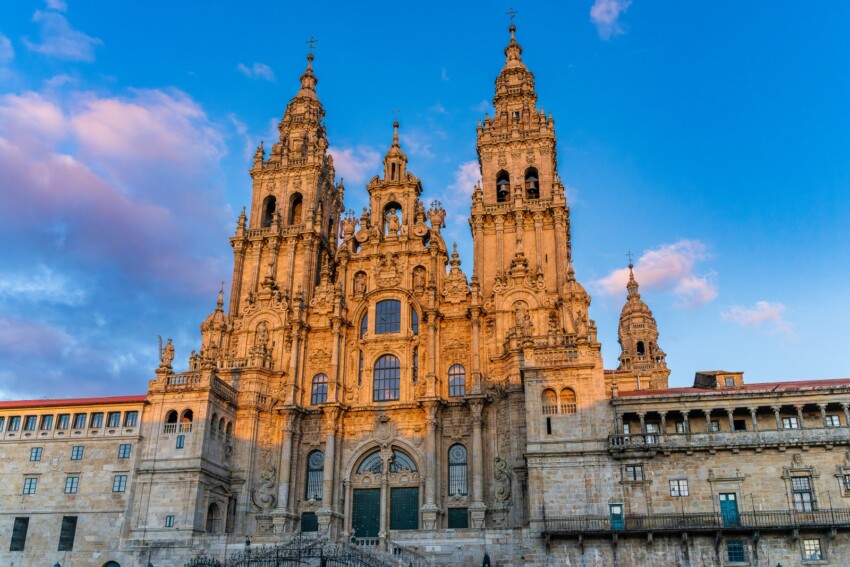
For those arriving in the city after the 800 km walk on the Pilgrim’s Way to Santiago, the Cathedral is the attraction to aim for. The sight of the Cathedral for pilgrims and walkers has an extremely important symbolic meaning: it represents the end of a long journey, but above all of a once-in-a-lifetime experience.
Other tourists cannot fail to be fascinated by the Cathedral, which dominates the city with its richly decorated spires and towers. Built between 1075 and 1211 and modified several times, it is a successful mix of Romanesque, Gothic and Baroque styles.
Santiago’s tomb under the high altar is the main attraction for many, but the cathedral’s artistic masterpiece is the Portico of Glory in the western entrance, embellished with 200 magnificent Romanesque sculptures depicting prophets and apostles; the central figure is Christ surrounded by the four evangelists, angels and symbols of Christ’s Passion.
For an unparalleled view of the city from above, join a guided tour of the cathedral, which also includes the church roof.
After visiting the cathedral, also take a look at the Puerta Santa: it is a door built in the 17th century that gives access to the church from Praza da Quintana, but is only opened in leap years. If the statues on the Portico de la Gloria excited you, here you can see 24 more (originally placed on the portico).
At the foot of Christ are statues of Santiago and Hercules. According to an old tradition, before entering the church, pilgrims had to recite a prayer by sticking their fingers into the five holes above the statue.
Another statue that is the subject of tradition is that of Maestro Mateo, the sculptor responsible for the magnificent decorations on the portico. According to tradition, knocking his head against the statue’s stone head served to acquire some of his genius.
Today you will no longer see people praying with their fingers stuck in holes in the wall or banging their heads against a statue: the two statues have been protected from overly lively pilgrims with metal bars.
After visiting the church, don’t miss the Cathedral Museum, spread over four floors. In addition to admiring an exceptional collection of sacred art, you can visit the cathedral’s 16th-century cloister, the sumptuous chapter house, a room decorated with tapestries designed by Goya, and the Pantheon of Kings, with the tombs of Leon’s medieval kings.
The museum and guided tour ticket also allows entry to the Pazo de Xelmírez, a 12th-century bishop’s palace attached to the north side of the cathedral. Here you can see an exhibition dedicated to the making of the sculptures of the Portico de la Gloria and a curious collection of busts depicting musicians and street artists.
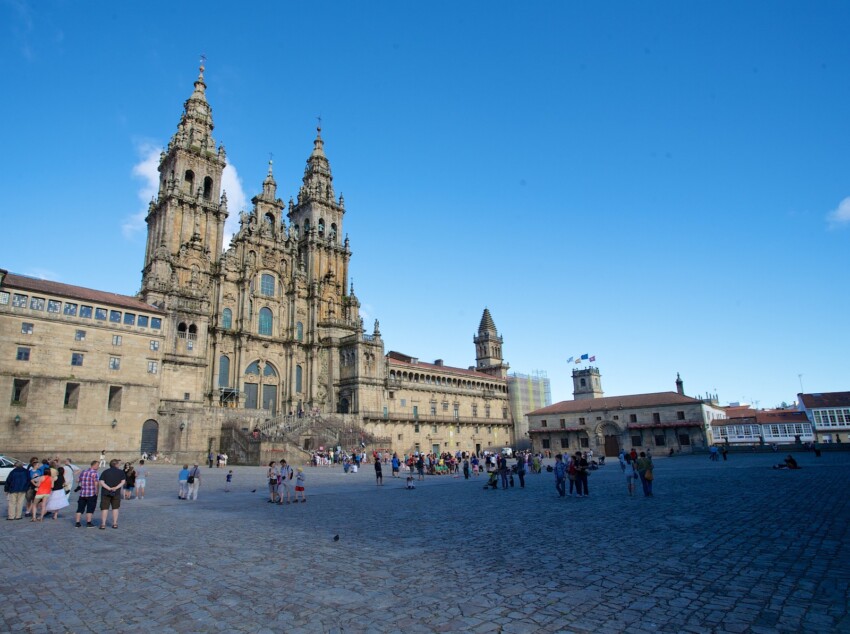
The city’s main square is the wide Praza de Obradoiro, so called because it was once home to bricklayers’ and stonecutters’ workshops.
It is a large square, rather unusual because it is closed to traffic and commerce. You will not find the cafés with outdoor tables typical of many European squares, but on the other hand you will find a unique silence and atmosphere. The square is overlooked by the majestic cathedral and elegant palaces including Pazo de Raxoi, now the town hall.
Another splendid palace overlooking the square is the Hostal dos Reis Católicos, a building with an ironic fate: built by the Catholic kings Isabella and Fernando to house first exhausted pilgrims, then orphans and the poor, it is now a parador, or luxury hotel that provides rest for wealthy tourists.
The gardens and some common areas are open to the public and can be visited independently; you can request a free map and read the comprehensive information panels.
The Mercado de Abastos is the second most visited place in the city after the Cathedral. This traditional market, dating back to 1873, is a reference point for Galician gastronomy. In its six pavilions one can find the best local produce: from fresh seafood to garden vegetables, from artisanal cheeses to freshly baked bread.
The market is particularly lively early in the morning, when local restaurateurs come to stock up. Many stalls offer the possibility of having freshly bought fish cooked in nearby restaurants.
The Alameda Park is the green lung of the city and offers the best panoramic views of the old town. This century-old park, with its majestic trees and well-kept gardens, is a popular meeting place for locals and visitors alike.
The ‘Paseo dos Leóns’ and the ‘Carballeira de Santa Susana’ are some of the most characteristic spots in the park. The statues of the ‘Two Marys’ have become a symbol of the city, commemorating two sisters who walked daily in the park in the 1950s.
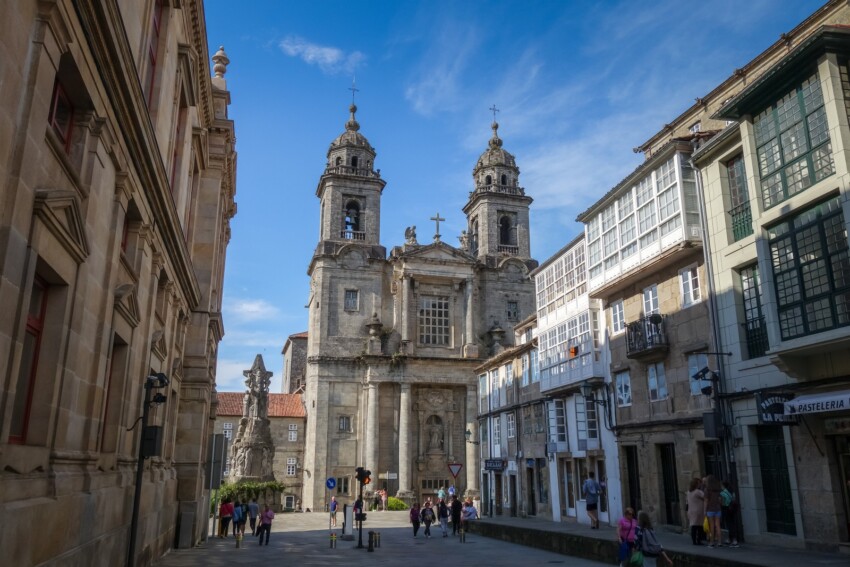
The San Francisco Convent is a splendid example of Gothic and Baroque architecture. According to tradition, it was founded by St Francis himself during his pilgrimage to Santiago. The cloister is particularly impressive, as is the museum that tells the story of the Franciscan order and the Pilgrim’s Way to Santiago.
The convent also houses a luxury hotel that maintains the spiritual atmosphere of the place. Its gardens offer an oasis of peace in the heart of the city.
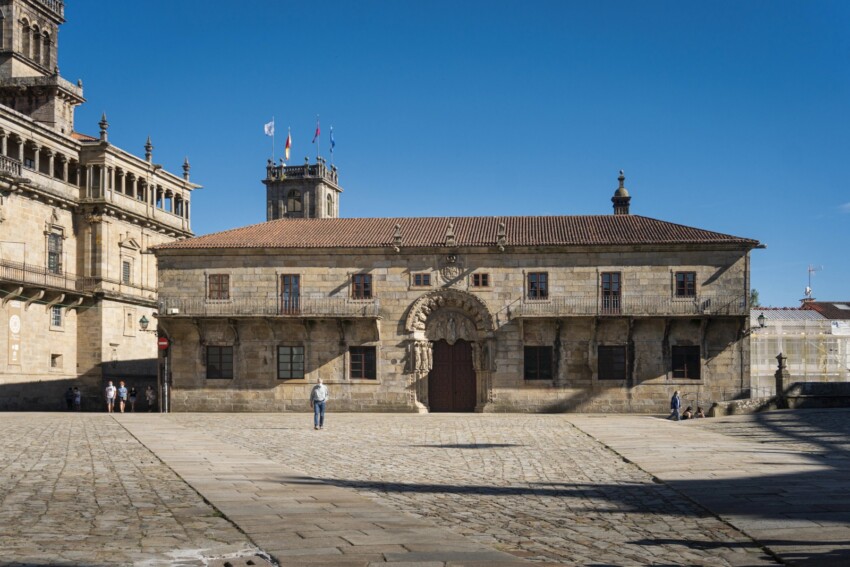
The University of Santiago, founded in 1495, is one of the oldest in Spain and gives the city a young and lively atmosphere. The university’s historical buildings, scattered around the centre, blend in perfectly with the city’s monumental heritage.
The Faculty of Geography and History and the Fonseca College are particularly beautiful examples of historic university architecture. The presence of students enlivens the numerous clubs and bars in the centre, creating an interesting contrast to the spiritual atmosphere of the city.
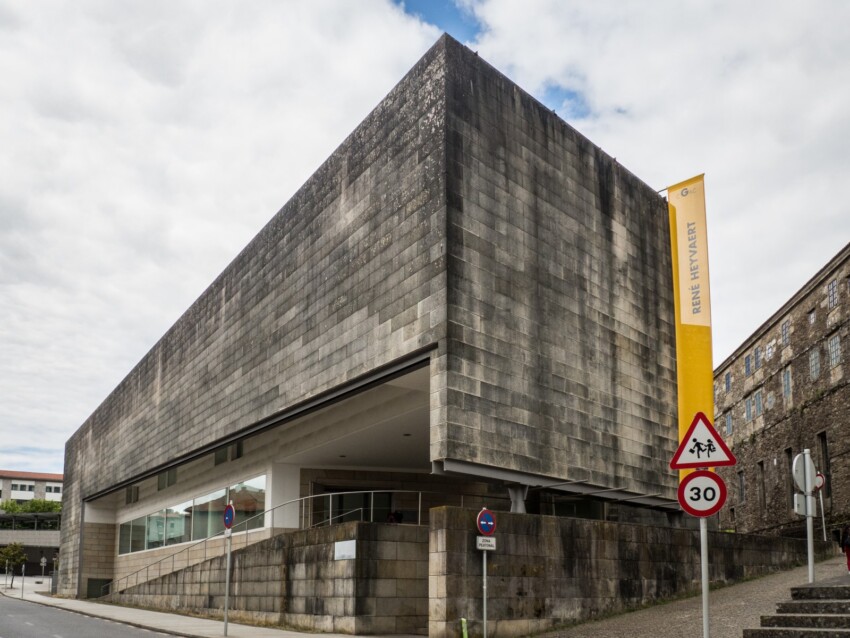
If you want to get to know the modern soul of Santiago de Compostela, visit the Galician Centre of Contemporary Art (CGAC), which together with the monastery of San Domingos de Bonaval and the park of the same name forms a unique complex in which modernity and tradition merge.
The museum exhibits works by Galician artists and organises temporary exhibitions that explore the latest trends in contemporary art, but it is the terrace with a view that attracts most tourists. It is definitely one of the best vantage points in the city.
The monastery houses another museum, the Museum of the Galician People, which is recommended for those who want to learn more about the different aspects that characterise Galician culture.
In the following map you can see the location of the main places of interest mentioned in this article.
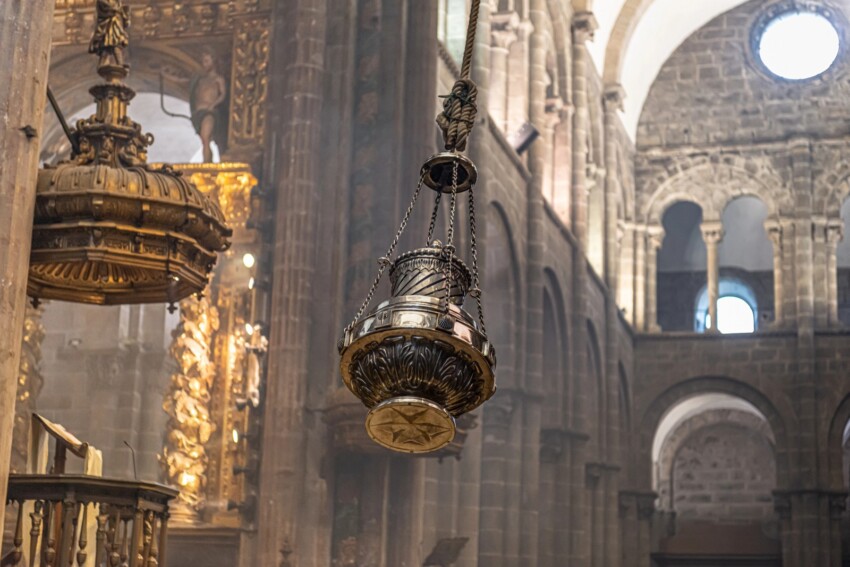
Santiago is a culturally vibrant city with a busy calendar of concerts, theatre, dance and exhibitions. Traditional festivities are very popular, the most important of which is the Feast of the Apostle, which takes place on 25 July, announced at midnight the previous day by the ringing of bells.
The festivities, a mixture of the sacred and the profane, include an offering to the Saint, the rite of the Botafumeiro (a huge censer is carried along the cathedral’s minor transept), the burning of a building that mimics the church façade. Throughout the city the music of the gaitas, the traditional bagpipes, resounds and people enjoy themselves dancing the typical dances.
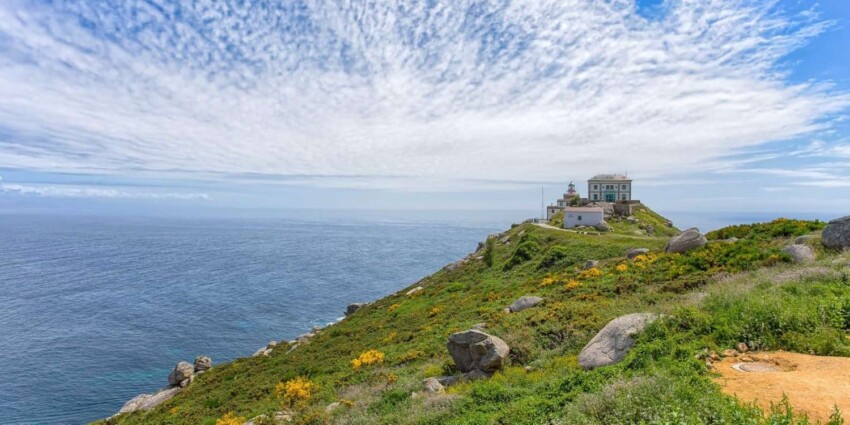
Here are three magnificent places around Santiago de Compostela that are definitely worth a visit. We recommend renting a car to explore these places, as some are easier to reach with your own vehicle. Each place offers a unique experience of Galician nature, history, culture and traditions.
Finisterre is located about 90 kilometres from Santiago de Compostela and can be reached in just over an hour by car. Its majestic lighthouse dominates a spectacular seascape, with sheer cliffs overlooking the Atlantic Ocean offering breathtaking sunsets. For pilgrims on the Pilgrim’s Way to Santiago, it is a symbolic place at the end of the pilgrimage, a point of arrival charged with spiritual and scenic significance.
The Ribeira Sacra is about 120 kilometres from Santiago de Compostela. It is an area of outstanding natural beauty, characterised by terraced vineyards that seem to be carved out of the steep canyons furrowed by the Sil and Miño rivers. It is a paradise for nature and food and wine lovers, with its heroic vineyards that produce wines of excellent quality and a heritage of medieval monasteries hidden among woods and cliffs.
About 70 kilometres from Santiago de Compostela, you can visit Mondoñedo, a historical jewel nestled in the Galician countryside, with a medieval cathedral dominating the historic centre. The town retains an old-world charm, with its cobbled streets, well-preserved historic buildings and an atmosphere that seems to stand still in time, allowing visitors to fully immerse themselves in the culture and traditions of authentic Galicia.
Perhaps due to the religious or non-snobbish tourism that characterises this city, a destination for many hikers, pilgrims and people looking for a sober and calm atmosphere, it is easy to find beautiful hotels and b&b’s in Santiago at a good price. Many are converted from historic buildings and have a warm and welcoming atmosphere.
The Historical Centre is the ideal place to stay, allowing you to fully experience the city’s magical atmosphere. Here you will find charming hotels converted from old aristocratic palaces, traditional guesthouses and tourist flats. The area around the Cathedral offers accommodation for all needs, from luxurious Paradores to boutique hotels.
The San Pedro district, just outside the historical centre, is a quieter but still central area. Here you will find modern hotels and more affordable flats, ideal for longer stays.
Many people arrive in Santiago de Compostela … on foot! If you don’t feel up to walking hundreds of kilometres, don’t worry because you can visit this picturesque town arriving by rental car, train or bus.
The AP-9 motorway connects Santiago with the main towns of Galicia and Portugal, the AP-8 follows the entire northern Spanish coast to France, while the A-6 highway and then the A-52 leads to Madrid. Calculate about 5 ½ hours from Madrid or Bilbao.
Those travelling by public transport will have no difficulty in reaching Santiago because it is well connected by buses and direct trains with the main Spanish cities and some international destinations.
What's the weather at Santiago de Compostela? Below are the temperatures and the weather forecast at Santiago de Compostela for the next few days.
Santiago de Compostela is located in the region of Galicia, on the north-western tip of Spain. It is located about halfway between La Coruna and Pontevedra, along the road that connects both of them and reaches as far south as Vigo.